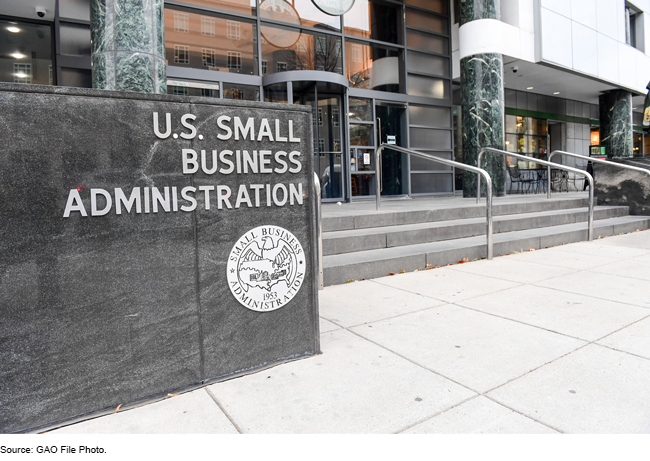Small Business Administration: Physical Disaster Loan Performance Before and After Changes in Statutory Collateral Requirements
Fast Facts
The Small Business Administration provides physical disaster loans to help businesses, homeowners, and others rebuild damaged property and to assist with recovery in declared disaster areas.
Through the Recovery Improvements for Small Entities (RISE) After Disaster Act of 2015, borrowers can obtain a loan for up to $25,000—instead of the previous $14,000 limit—without pledging any collateral.
We reviewed more than 20 years of loan data and found that the loans approved before the change in collateral requirements had higher default rates than the loans approved after the change. However, this statistic may change over time as newer loans mature.

Highlights
Why GAO Did This Study
SBA assists most types of businesses regardless of size and others affected by natural and other declared disasters through its Disaster Loan Program.
The Rebuilding Small Businesses After Disasters Act included a provision for GAO to review the performance of SBA's physical disaster loan portfolio and compare the performance of loans made before changes to the collateral requirements because of the RISE After Disaster Act of 2015 to loans made after the changes were in effect.
To perform this work, GAO obtained and analyzed loan data made under SBA disaster declarations from January 1, 2000, to September 30, 2020; reviewed relevant federal laws and regulations; and interviewed SBA officials.
What GAO Found
When disaster strikes, the Small Business Administration's (SBA) Disaster Loan Program provides direct assistance in the form of low-interest loans. Physical disaster loans can be used to rebuild and replace uninsured or underinsured property damaged in a declared disaster area, helping homeowners, renters, businesses, and nonprofit organizations. But in order for an applicant to qualify for SBA's physical disaster loans, the property damage must occur in a federally declared disaster area. The President can issue a major disaster declaration in response to a request by the governor of a state or territory or the chief executive of a tribal government. For an event that does not rise to the level of a presidential disaster declaration, the SBA Administrator can issue an agency disaster declaration in response to a timely request by a state governor. The Recovery Improvements for Small Entities (RISE) After Disaster Act of 2015 temporarily modified collateral requirements for loans approved under SBA disaster declarations. Specifically, the act temporarily raised the limit for loans without collateral from $14,000 to $25,000. The increase expires on November 25, 2022, when, absent further revision of the statute, the amount will revert back to $14,000.
GAO reviewed SBA's $855 million of approved physical disaster loans made under SBA disaster declarations from January 1, 2000, to September 30, 2020. GAO found that default and charge-off rates were higher for loans that were approved before the collateral changes that the RISE After Disaster Act of 2015 made when compared to loans approved after these changes were in effect. However, as the loans made after the RISE After Disaster Act of 2015 have more time to mature, their default and charge-off rates may increase. Loans made before the RISE After Disaster Act of 2015 have had approximately 5 to 20 years to mature, while the loans made after have all had less than 5 years. GAO's analysis did not isolate the contribution the collateral changes made to the difference in loan performance from other contributing factors, such as the state of the economy or changes in SBA lending practices.
To minimize the effect of the difference in time of performance of the two groups of loans, GAO assessed the performance for the initial 4 years following loan disbursement of subsets of loans made approximately 5 years before and after the RISE After Disaster Act of 2015. GAO found that for these subsets of loans, the default and charge-off rates varied by less than one percentage point for each of the years. In addition, GAO compared the performance of loans with collateral to the performance of loans without collateral and found that loans with collateral did not necessarily perform better than those without collateral.
For more information, contact Cheryl Clark at (202) 512-9377 or clarkce@gao.gov.
